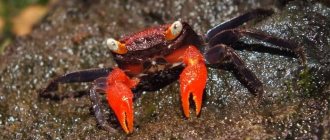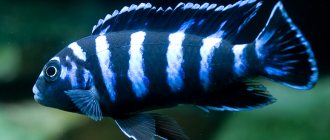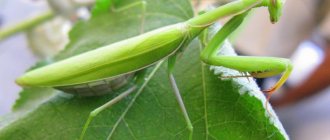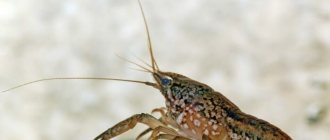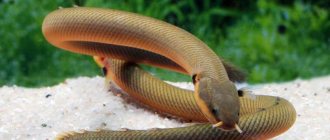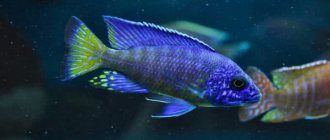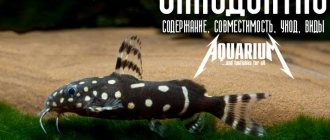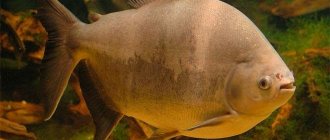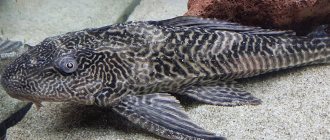Its impact is stronger than a bullet, its vision is capable of perceiving ultraviolet and also infrared radiation and recognizing cancer cells, and its memory is considered the best among representatives of the animal world. The mantis shrimp may well lay claim to the title of the most amazing creature on planet Earth. But this animal cannot be classified either as a crayfish, or as a shrimp, or as a praying mantis. It belongs to a separate species of stomatopods. It is characterized by incredible aggression and poses a mortal danger to others.
general description
The mantis crab (oratosquilla oratoria) is a crustacean sea creature that belongs to the phylum Stomatopod. It got its name because of its bent forelimbs, which have a strong resemblance to the paws of an insect - a praying mantis. The second pair of jaws has incredible strength. This is what the praying mantis uses to capture and destroy prey. He hits not only hard, but also very quickly - faster than a person can blink.
Another name for the animal is the Peacock shrimp (odontodactylus scyllarus), which it received because of its bright, variegated color.
What does it look like
In appearance, crayfish is similar to insects and shrimp. It has a bright color. Males can boast of a variety of colors on their bodies, which shimmer with all the colors of the rainbow. This is a striking combination of a mixture of red, blue, green, pink and turquoise. Under optimal conditions of existence, mantises can reach a length of 20, and in exceptional cases even 40 cm. But the size is taken without taking into account the claws. The flattened, elongated body, divided into separate tagmas (segments), is brown-olive in color in females and bright green in males, covered with a dense chitinous cover.
Wonderful eyes
Like all crustaceans and insects, mantis shrimp have a very complex eye structure, reminiscent of the eyes of crabs, bees or butterflies. Each organ of vision has hundreds of individual facets, each of which represents an integral part of the entire compound eye. But the eyes of mantis shrimp are much more specialized than all other compound eyes.
On the one hand, each visual organ is like three eyes compressed into one. All three parts are looking at the same point in space, just as our two separate eyes are focused on the same scene. We use our two eyes to find an object in space. Mantis shrimp can determine the distance to objects they are looking for using only one eye.
The two parts of the eye, located above and below, are likely involved in this "remote vision". The third part is built from parallel rows of facets that encircle the middle of the eye. There are usually six rows, although a few species have only two. This part of the eye is called the "median" and it supports many special abilities.
Additionally, most mantis shrimp see ultraviolet light, the part of the electromagnetic spectrum that causes sunburn. The human eye does not see this radiation. Mantis shrimp not only sense this light, but with their specialized mid-stripes they can even distinguish individual colors.
This feature sits on top of another set of color detectors that detect the same visible light we're used to. But in eight color channels, as opposed to the three primary colors that we see. Imagine that you are trying to tune a TV that a mantis shrimp is watching. In addition to the red, green, and blue colors your TV uses to create a bright picture, this will require pixels for violet, indigo, blue-green, orange, and deeper reds than we can see.
And this “visual belt” can do much more. It can detect the polarization of light: where all the waves vibrate in the same plane. Our eyes do not see this property of light.
Thus, summoning all its visual talents, the mantis shrimp sees fish in patterns of ultraviolet color, the eight primary regular colors, and polarized light. Their eyes collect all this information and relay it to the animal's brain to decide whether to attack prey, when to attack it, how far away it is, and what it looks like from different perspectives. It is difficult for a person to imagine the visual world of a mantis shrimp.
Unique features of the mantis crab
The shrimp has unique features that are not characteristic of any other representative of the animal world. Thus, they are able to recognize individuals of their own species. This is due to the ability of these sea creatures to leave behind a characteristic smell, which allows them to distinguish each other.
The eyes of the mantis crab that see everything
The praying mantis has the broadest visual spectrum of any animal and has 16 photoreceptor cell types. For comparison, a person has only 2 of them. Hexonocular vision in cancer has 3 focusing points, which is why it can capture ultraviolet and infrared radiation.
Has the widest visual spectrum of any animal
This miracle creature is able to see cancer cells. Therefore, scientists continue to work on creating a camera similar to the vision of the mantis crab in order to see cancer in the early stages.
Such unique visual features allow the marine animal to see all the smallest details around. In addition, it has excellent memory and is able to remember its neighbors. When strangers appear, the shrimp furiously rushes to attack.
Amazing punching power
A .22 caliber bullet can be as powerful as the claws of a mantis shrimp. The special structure of muscles and claws contributes to this. This is the secret of such striking force. During an attack, the leg muscles contract and are held in this state by a special snap joint. When struck, the latch opens and the muscle is released instantly.
Creepy singing
The amazing abilities of the sea shrimp don't stop there. Thus, it was found that she is capable of making sounds similar to an elephant’s roar, only many times quieter. To do this, scientists placed microphones in an aquarium with stomatopods.
The singing of cancer evokes horror and fear. But it is still not clear what exactly they make sounds with. Most likely, this is not the mouth of a sea devil.
Lifestyle
These aggressive and usually solitary marine crustaceans spend most of their time in burrows. The finished burrow usually has two exits, and water, which is directed by the flapping of the front abdominal legs, flows freely through it. The burrows of Lysiosquilla excavathrix reach a depth of 1 meter. Mantis crabs leave their homes only to feed and search for a new hole (as they grow); can be active during the day, at night or at dusk (depending on the species). Climbing out, they crawl along the surface of the ground with the help of their hind thoracic legs, as well as their hunting jaws, which at the same time bend and on which the crayfish leans, like crutches. Small species of the genera Gonodactylus and Coronida hide in crevices and crevices between coral branches. Some small species use the burrows of larger ones.
Raoulserenea hieroglyphica
Mantis crayfish live a long time. They have a good memory and are able to recognize individual neighbors with whom they often interact.
Is it dangerous for humans?
Cancer poses a huge threat to humans. Even the ability to see a creature in front of it that is significantly larger than itself does not make the animal afraid. A person's desire to touch or pick up a handsome man can result in death. However, not only because of the blow, but because of a possible infection. After all, a predator is capable of cutting hands with its claws.
Cancer poses a huge threat to humans
Vampyroteuthis infernalis
Or just a hellish vampire squid - it’s not entirely clear why he was given such a nickname. The peculiarity of this mollusk is that it is the only cephalopod living at a depth of 400 - 1000 m. It has large gills, a high copper content in the blood and very slow life processes, which is why its muscles are poorly developed, and it unable to escape from predators. But he is able to defend himself. When attacked, the mollusk releases a luminescent liquid, which disorients the enemy. While the predator does not understand what, in fact, is the matter, this cunning asshole swims to a safe distance for him and spreads his tentacles widely, visually increasing in size.
There have been no recorded cases of attacks on vampire squids. But when catching sperm whales, which are common in the habitat of these mollusks, it is extremely rare to find squid in the stomach of the predator, which fully proves the effectiveness of their self-defense.
Keeping mantis crayfish in an aquarium
Keeping a praying mantis in an aquarium is not that difficult. The main thing is to remember the danger that comes from this creature. Of course, in order to exist, it needs to organize conditions as close as possible to natural ones.
Conditions of detention
The praying mantis must be kept separately from other marine life. The exception is large, active triggerfish and groupers. An aggressive shrimp needs a large tank made of particularly durable material that can withstand severe impacts. The bottom should be lined with a thick layer of sand or other soft soil.
Cancer does not need bright lighting, so the light should be twilight. The water flow is weak.
Feeding in an aquarium
You can use the following as pet food:
- special mixtures for aquarium crayfish:
- living inhabitants of the sea - snails, mollusks, crabs.
Special mixtures can be used as food.
Being a predator, the animal will gladly eat the meat of other types of shrimp and mussels. When feeding, you need to use long tweezers, avoiding touching them with your hands.
Spreading
Its habitat is located in the Indo-Pacific region of the World Ocean and extends from the east coast of Africa to Japan and Australia. In the east, its border passes through the Mariana Islands, located in the western Pacific Ocean.
The luxurious mantis crayfish settles in coastal waters at a depth of 3 to 40 m, up to a maximum of 70 m. It is found mainly on a sandy or gravel bottom in the vicinity of coral reefs.
The animal is very sensitive to environmental pollution, therefore it is considered a kind of biological indicator.
- long eared hedgehog
- Cross spider
- Reptiles
- 72 facts about plants
- Animals of Siberia
- 35 facts about giraffes
Reproduction
Cancer-Mantis refers to creatures of different sexes that may not change pairs over several mating periods. But this doesn't always happen. Some representatives of stomatopods are polygamous. During the mating season, several males fight for one female. It goes to the winner, while the loser is most often destroyed.
At home, you will not be able to get offspring from a peacock shrimp. The larvae are not able to survive in unnatural habitat conditions.
Interesting facts about the animal
There are many amazing facts related to the mantis shrimp:
- the claw impact speed when destroying a crayfish victim is about 80 km per hour;
The impact speed of the claws when destroying a victim is about 80 km per hour
- the animal has the most complex eye structure, which consists of 1000 facets, which allows them to see prey in a timely manner, determine distances, and recognize varieties of coral reefs;
- large species of mantises easily break aquarium glass;
- On the claws at the point of contact with the body of the victim during a blow, the crayfish forms bubbles, which in their temperature are comparable to the temperature of the surface of the sun.
Interestingly, male crayfish can also incubate eggs that the female has prepared. She divides them into two clutches, one of which she gives to her partner, and the other she hatches. Males, like females, take care of their own offspring.
Mantis crabs will help create new impact-resistant materials
Today, scientists around the world are struggling to create impact-resistant materials based on the characteristics of the chitinous cover of stomatopods, especially the covering of its legs. After all, they combine unusual hardness and lightness at the same time. The shell contains calcium and phosphorus, just like human teeth. But in comparison with them, the shell of the legs of the mantis crab is much stronger and can withstand blows of enormous force. Based on this cover, scientists are trying to create a miracle material that will become excellent armor for military equipment.
The mantis's leg shell can withstand blows of enormous force.
Mantis crab in the Red Book
Today, hunting for predators all over the world is carried out on an industrial scale. However, in Russia it is listed in the Red Book under the 4th category, denoting an uncertain species by status. In the near future, there will most likely be a need to introduce restrictions on the catch of crayfish.
The mantis shrimp will be interesting to watch for lovers of exotic animals. It can become a true decoration of a home aquarium. Just don’t forget about your own safety if you want to pick up a colorful, incredibly spectacular crayfish.
Would you risk having a mantis crayfish in your aquarium? Share your opinions about this unusual animal in the comments.
Population and species status
Photo: Bogomol
Populations of some species of this unusual insect are becoming increasingly small, especially for species living in the northern and central regions of Europe. In warmer regions, the mantis population status is stable. The main threat to these insects is not their natural enemies, but human activity, as a result of which forests are cut down and fields, which are the habitat of mantises, are plowed up. There are situations when one species displaces another, for example, a tree mantis, living in a certain area, displaces the common mantis from it, since it is particularly voracious, it is stronger and more aggressive than its relative.
In cooler areas, these insects reproduce very slowly and the larvae may not be born for up to six months, so their numbers take an extremely long time to recover. The main task for maintaining the population is to preserve the steppes and fields untouched by agricultural machinery. Praying mantises can be very useful for agriculture, especially the less aggressive species.
Mantises are not dangerous to humans despite their sometimes very frightening appearance and menacing hissing. Some particularly large individuals, due to their strong jaws, can damage the skin, so they should be kept away from children. Such an amazing and strange insect as a praying mantis leaves no one indifferent. While many scientific minds continue to argue about the main stages of its evolution and ancient ancestors, some, having carefully examined the praying mantis, call it an insect that arrived from another planet, a creature of extraterrestrial origin.
Tags:
- Mantinae
- Mantini
- Mantis
- Panarthropoda
- Polyneoptera
- Praying Mantis
- Bilaterally symmetrical
- Wild animals of Africa
- Wild animals of Russia
- Animals of Australia
- Animals of Australia and Oceania
- Animals of Azerbaijan
- Animals of Africa
- Animals of Belarus
- Animals of Germany
- Animals of Greece
- Animals of Eurasia
- Animals of Europe
- Animals of India
- Animals of Indochina
- Animals of Spain
- Animals of Cyprus
- Animals of China
- Animals of the forest
- Animals of the forest-steppe
- Animals starting with the letter B
- Semi-desert animals
- Animals of Portugal
- Desert Animals
- Animals of deserts and semi-deserts
- Animals of Russia
- Animals of North America
- Animals of the steppe
- Animals of the Subtropical Zone of the Northern Hemisphere
- Animals of the Subtropical Zone of the Southern Hemisphere
- Animals of the Subequatorial Belt of the Northern Hemisphere
- Animals of the Subequatorial Belt of the Southern Hemisphere
- Animals of Tatarstan
- Animals of the Tropical Zone of the Northern Hemisphere
- Animals of the Tropical Zone of the Southern Hemisphere
- Animals of Ukraine
- Animals of the Temperate Zone of the Northern Hemisphere
- Animals of the Temperate Zone of the Southern Hemisphere
- Animals of South America
- Winged insects
- Shedding
- Real praying mantises
- New-winged insects
- Protostomes
- Cockroaches
- Tracheal breathing
- Arthropods
- Hexapods
- Eukaryotes
- Eumetazoans
